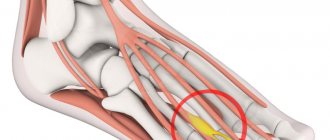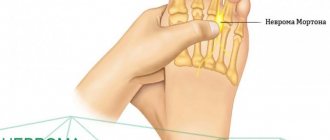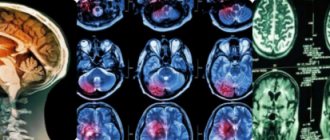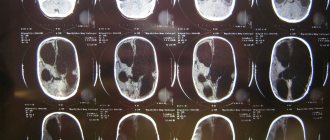| Diabetic neuropathy | |
| Tuning fork - a tool for diagnosing peripheral sensitivity disorders | |
| ICD-10 | 63.263.2, 10.410.4, 11.411.4, 12.412.4, 13.413.4, 14.414.4 |
| ICD-9 | 250.6250.6 |
| MedlinePlus | 000693 |
| MeSH | D003929 |
Diabetic neuropathy
(ancient Greek νεϋρον - “nerve” + ancient Greek πάθος - “suffering, illness”) - disorders of the nervous system associated with damage to small blood vessels in diabetes (vasa vasorum, vasa nervorum) - one of the most common complications, not only leading to decreased ability to work, but also often causing the development of severe disabling lesions and death of patients. The pathological process affects all nerve fibers: sensory, motor and autonomic. Depending on the degree of damage to certain fibers, various types of diabetic neuropathy are observed: sensory (sensitive), sensorimotor, autonomic (autonomic). There are central and peripheral neuropathy. According to the classification of V. M. Prikhozhan (1987), damage to the brain and spinal cord is considered as central neuropathy and is accordingly divided into [1]:
- dysfunction of the central nervous system in acute comatose states;
- acute cerebrovascular accidents;
- subacute disorders of brain activity in renal failure (uremia);
- neurosis-like (psychopath-like) states;
- diabetic encephalopathy;
- diabetic myelopathy.
Features of the pathology
Damage to nerve tissue is typical for people who have lived with diabetes for many years. Statistics show that at least 54% of patients with sweet illness face this problem. Life activity depends on the regulation of the peripheral nervous system. Neurons in this group are responsible for heartbeat, breathing, food digestion, signals to the brain, and even muscle contraction.
Diabetic neuropathy is a nervous system disorder that affects the legs of patients. The lesion starts from the diabetic's foot and gradually moves higher. The mechanism of the spread of pathology by doctors has not been fully studied. Depending on the type, diabetic neuropathy can manifest itself in different ways.
The stages of the disease that accompany diabetes are equally dangerous for humans, and, of course, necessarily require immediate and long-term treatment. Lack of treatment for diabetic neuropathy leads to irreversible consequences: gangrene and necrosis, leading to disability.
Neuropathy of the lower extremities is a diabetic infection that makes the life of patients unbearably difficult. This disease refers to complications of types 1 and 2 diabetes, which, one way or another, sets restrictions on a full-fledged existence.
This pathology causes disorders of adequate sleep. One way or another, almost every patient with pathology of the endocrine system suffers from sleepless nights. What medications to use, as well as treatment methods for the lower extremities affected by diabetic neuropathy will be discussed further.
The division of the nervous system into two types provokes the division of disorders into types:
- diabetic autonomic neuropathy - causes problems with the urinary and cardiovascular systems, often with fatal outcomes, and leads to disorders of male sexual function;
- somatic polyneuropathy - causes the formation of ulcers on the legs, which take a long time and are difficult to heal, and can develop into gangrene.
There is also a classification based on the functions of the nervous system with which problems arise:
- increased pain in the legs or lack of sensitivity is characteristic of sensory polyneuropathy;
- thinning muscle mass, inability to move - typical manifestations of motor polyneuropathy;
- the combination of manifestations of both pathologies is characteristic of sensorimotor polyneuropathy. This mixed type of illness is manifested by a complete loss of sensitivity to pain in certain places.
The danger of the disease lies in the fact that patients do not feel cold and heat. The feet cannot be controlled; when walking, patients involuntarily raise their legs higher than they should be.
Diabetic neuropathy - what is it?
It is important to know! A new product recommended by endocrinologists for permanent control of Diabetes! You just need every day... Read more >>
This disease is a malfunction of peripheral nerve fibers. They can be extensive or local, affecting several systems or just one organ. At a doctor's appointment, neuropathy is detected in every seventh patient with diabetes, and with the help of more sensitive electrophysiological methods - in every second.
The first sign of the disease is a decrease in the speed of propagation of excitation in nerve fibers. Severe forms of neuropathy are characterized by sensory disturbances, severe pain, organ failure, muscle weakness, and even disability.
Differences between neuropathy and polyneuropathy
Neuropathy (in medical terms you can find the name neuropathy) is the destruction of nerve tissue. A process that disrupts the integrity of the nerve or sheath.
In medicine, neuropathy has several directions that differ from each other. Thus, neuropathy is a condition in which 1 nerve is affected, which causes disruption of motor functions. Muscle weakening, lethargy, pain and increased sensitivity may occur. The reasons why neuropathy develops include:
- Nerve compression. Stiffening of the limbs, pinching of the nerve root due to advanced osteochondrosis or hernia.
- Development of the inflammatory process.
- Diabetes.
- Bruises, sprains, tears and complete rupture of nerve tissue.
- Intoxication with alcohol and toxic substances.
When multiple nerve endings are affected, this phenomenon is called polyneuropathy.
The most common reasons for the development are:
- The development of neuropathy as a result of the inflammatory process. The disease is called Guillain-Bare.
- Alcohol addiction. Alcoholic polyneuropathy causes disruption of motor functions and sensitivity of the skin. Over time, the disease affects the brain, causing memory problems.
- Diabetes mellitus causes disruption of the blood supply to the nerves responsible for sensitivity.
- Infection of small vessels with fungal infections.
- Allergic reactions to vaccination. Muscle paralysis may occur in the area of the injection, and motor functions may be impaired and not restored.
- Diphtheria, spreading through the blood, destroys small vessels.
The disease requires competent medical treatment.
Causes
The main causes of diabetic polyneuropathy of the lower extremities:
- Metabolic. Disruption of metabolic processes in nerve cells occurs as a result of a prolonged increase in blood sugar levels.
- Hereditary. Diabetes can occur not only in adults, but also in children who have a genetic predisposition if their parents or close relatives had this disease.
- Vascular. Negative effects of microangiopathy (a disease in which small vessels and arteries are damaged).
- Dysimmune. The influence of autoimmune processes in the patient’s body. Individuals suffering from this disease have been found to have elevated levels of cytokines and show signs of vasculitis.
Additional etiological factors:
- endocrine disorders;
- liver or kidney pathologies;
- depressive states;
- weakened immune system;
- infections;
- alcoholism;
- poisoning with toxic substances;
- neoplasms.
Symptoms
Diabetic neuropathy in diabetes mellitus primarily affects the lower extremities, in some cases spreading to the arms.
The development of pathology has several stages, with different manifestations:
- Subclinical - passes with virtually no pain. At this stage, the beginning of damage to nerve tissue begins. There is a deterioration in sensitivity to changes in temperature, vibrations, and pain is not felt.
- Clinical. The second stage of the disease is characterized by pain of varying intensity, regardless of the part of the body, sensitivity to external factors rapidly decreases, and limbs go numb.
- The stage at which the skin of the patient’s extremities becomes covered with ulcers, which often cause pain. At this stage, gangrene may develop, the formation of which leads to amputation of the limb.
The clinical stage has several forms:
- Chronic, in which burning and colic in the legs are added to the main symptoms. It is more pronounced at night.
- Painless. This form is characterized by numbness of the foot and a complete lack of sensation in the limbs.
- Amorphous. Here, in addition to all these symptoms, weakening of muscle tissue appears and difficulties in movement arise.
There are also general symptoms characteristic of diabetic neuropathy:
- appearance of seizures;
- characteristic headache;
- frequent limb cramps;
- inability to experience orgasm;
- frequent dizziness;
- speech defects;
- weakening of muscle tissue;
- diarrhea;
- uncontrolled urination;
- The lower limbs begin to go numb, completely or in separate areas;
- pain in the legs;
- visual impairment;
- problems with movement.
If you observe these symptoms, you should immediately consult a doctor.
Diagnostics
The need to visit a medical center is indicated by the presence of several symptomatic manifestations. Specialists in this field are considered to be an endocrinologist, neurologist or surgeon. When making a diagnosis, the patient’s complaints, examination results and laboratory tests are taken as a basis.
The examination is focused on determining the tendon tissue reflex and sensitivity to external factors.
Diagnostics in laboratory conditions shows the level of:
- cholesterol;
- lipoproteins;
- blood and urine sugar;
- glycated hemoglobin;
- C-peptides.
Instrumental examination is no less important for making a diagnosis. An accurate diagnosis can be made using the following diagnostic methods:
- electrocardiogram and ultrasound examination of the heart muscle;
- electroneuromyogram;
- Magnetic resonance imaging;
- biopsy.
One of the above methods will not be enough. An integrated approach is needed.
Prevention for diabetes mellitus
Polyneuropathy is a common complication of diabetes. To prevent the development of the disease, it is worth taking preventive measures:
- examine the vessels twice a year and undergo treatment with drugs to improve the condition of the arteries;
- monitor sugar levels;
- if you suspect neuropathy, immediately contact an endocrinologist;
- follow a diet;
- perform special exercises to improve blood supply to the legs.
Treatment
Neuropathy in type 1 and type 2 diabetes cannot be completely cured. In this case, treatment is designed to stop the further development of the pathology. The first step is to maintain a normal blood glucose level in case of diabetes.
For neuropathy, the medicine should reduce painful manifestations; for this purpose, patients are prescribed analgesics. Wearing comfortable shoes, reducing movement on your feet will help eliminate the pain, and a contrast shower will help relieve the burning sensation of your feet.
It is important to take medications that help dilate peripheral vessels, which are responsible for transmitting nerve impulses.
Treatment of the legs should be carried out through the intake of B vitamins. Also, diabetic neuropathy of the lower extremities forces one to monitor the consumption of carbohydrates and follow a diet.
Taking medications
Treatment of diabetic neuropathy is carried out using a large number of medications.
The most commonly used drugs are:
- Anti-seizure medications: Lamotrigine, Pregabalin;
- analgesic with narcotic base: Tramadol, Targin;
- vitamin complex;
- a drug for the restoration of damaged nerve tissue;
- antidepressants: Duloxetine, etc.;
- medications aimed at increasing blood flow to the nerves;
- medications that increase the protection of nerve endings from sugar - Sorbinil, Isodibut;
- antibiotics, for ulcers with a risk of gangrene formation.
All medications should be prescribed only by the attending physician.
Non-drug treatment
You should not hope that home treatment or traditional medicine alone will be enough for a complete recovery. Here, attending the following procedures will be effective, along with simultaneous drug treatment.
Necessary procedures:
- magnetic therapy;
- hyperbaric oxygen therapy;
- massages;
- electrical stimulation;
- acupuncture;
- physical therapy exercises
The use of medications will improve the patient’s condition, alleviate symptoms and eliminate the cause of neuropathy. For the effect to be noticeable, it is better to use a complex of several methods to combat complications.
Folk recipes
Many doctors recommend using traditional medicine along with medications to treat the consequences of diabetes.
In folk medicine they often use:
- herbs;
- clay;
- calendula;
- dates;
- burdock roots;
- goat milk;
- nutmeg;
- mumiyo;
- honey and lemons;
- garlic;
- laurel leaf;
- Jerusalem artichoke root;
- apple cider vinegar.
Before self-medicating, you need to determine the degree of advanced disease, which only a doctor can do.
He will determine exactly which products will be effective. You cannot take folk remedies as the basis of treatment; they are used as an addition to drug therapy and to prevent complications of diabetes.











